TIME AS AGENT TO IMPLANT PRODUCTIVE MILIEUS
And to Rethink New Interactions between Human and Nonhuman
Céline Bodart (BE) / Dimitri Szuter (FR)
Céline Bodart, architect, researcher, professor and member of the Europan’s technical committee
Dimitri Szuter, architect, teacher, performer and member of the Europan’s technical committee
Part of the E15 Results catalogue, published by Europan Europe in Sept. 2020, this article presents three strategies for the implantation of new productive milieus:
1- intensifying nonhuman resources; 2- arranging human resources; 3- constructing the timeframes of transformation.
Time as Agent to Implant Productive Milieus
And to Rethink New Interactions between Human and Nonhuman
Implanting, is less to act on a territory than to interact with everything that is part of it, everything that makes it a natural, cultural, social and economic milieu. In this Session 15 of Europan, several projects in fact take the view that the implantation of new productive milieus is primarily a matter of thinking how to revitalise the multiple components of the territory symbiotically; conceiving how to activate human and nonhuman resources within it as well as an ecosystem of partners. Three strategies for the implantation of new productive milieus are presented here, differing in their methods of catalysing their transformation processes: 1) the project begins by identifying and activating the territory’s nonhuman resources; 2) the project focuses on the collective human scale and organises the socio-productive future of the milieu around new urban figures; 3) the project is embedded in the territory through a tactical reconsideration of the timeframes and rhythms of its own transformation process.
I- INTENSIFYING NONHUMAN RESOURCES
The big challenges raised by uncertainty force designers to reconsider what constitutes a resource in our time. The project embraces the nonhuman as a new agent of territorial transformation. Through this new way of attributing attention and importance to nonhumans, we see a renewal of design practices. Three forms of intensification of nonhuman resources are proposed here: harmonising with the metabolic cycles of the milieu; unfolding and exploring the agency of landscape entities; advancing our territorial attachments as new guiding principles of the project.
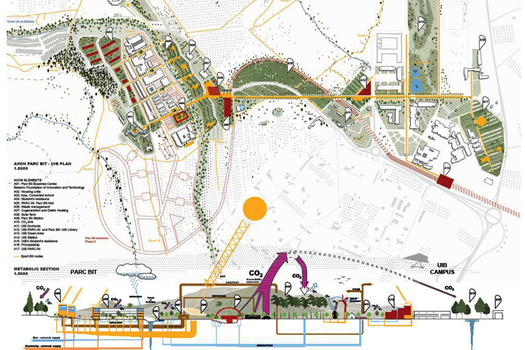
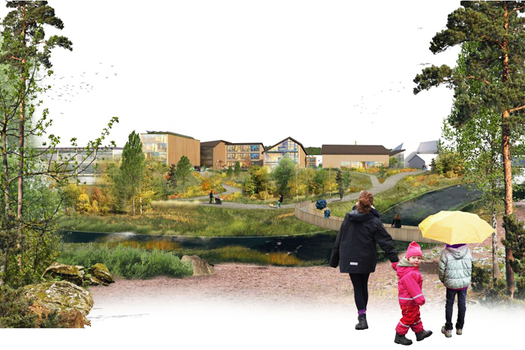
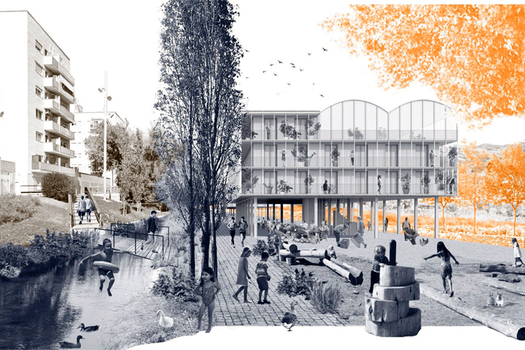
Whether we call it the “Anthropocene”, or prefer the terms “Capitalocene” or “Technocene” (A.Tsing), there is a general consensus around the urgency of rethinking the interactions that we maintain with our milieus. For many, the guiding principle of transforming milieus is no longer the anthropocentric idea of progress, but about espousing the metabolic cycles that produce and condition their possible futures. In Palma (ES), the special mention project Parc-In (fig.1) develops a strong central thread in its approach: reducing CO2 emissions by replacing individual mobility and its dedicated spaces with new green mobilities, accompanied by large-scale planting. The team’s aim with this is to implant new, long-term ecological cycles that (re)generate pure air. While it is the atmospheric cycles that become the generators of the project in Palma, it is future living/survival conditions that concern the designers of the special mention project Today Tomorrow (fig.2) in Raufoss (NO). The proposal begins by contrasting the abundance of resources currently available in Norway with the risk of these resources diminishing or even disappearing in the future. In order to plant the manifest seeds of the transition (R. Hopkins, 2008), the team wants to implant the potential of the Skogen River by increasing its agricultural use and converting this wetland milieu into a nucleus of production and sociability. In both Palma and Raufoss, therefore, the aim is to harmonise the transformation project with the metabolic cycles of the milieu. This emphasis on cycles encourages urban and territorial production to move away from its patterns of resource consumption in order to intensify the productive and reproductive potential of the milieu.
2. THE AGENCY OF LANDSCAPE
This refers to an approach that treats landscape entities in terms of their agency, in other words their capacity to act and interact with the changes planned (E.Wall, T.Waterman, 2018). In Vallbona (Barcelona, ES), this idea becomes the conceptual structure of the entire runner-up project Blue Lines (fig.3). Between the canal and the river, the water cycle forms a landscape with natural productive qualities that have been eroded by overuse of the valley floor by road and rail infrastructure. In order to overcome these artificial boundaries, Blue Lines proposes to reshape and reinforce the metabolism of this landscape through the outlines of a new irrigation plan: transversal water corridors supplying large numbers of productive gardens, as well as new housing clusters. The productive and ecological renewal of human facilities thus takes place in interaction with what the river landscape allows and imposes. For the team that designed the runner-up project 60°North (fig.4) in Tuusula (FI), the challenge is to make the project the medium for new productive relations between the urban and the rural, between consumers and producers, in order to short-circuit the existing dependency relations and reinvent new patterns of territorial interdependence. The team shapes its proposal around a “nonhuman” scale, in this case Tuusula Lake. The lake, as a landscape element with certain aesthetic qualities, is the scale of reference in relation to which the productive, ecological, economic, social and cultural transformation of the territory can take place. It is the scale of belonging and of governance, of production and cooperation.
3. TERRITORIAL ATTACHMENTS
In response to the ecological, social and political devastation of milieus, we are witnessing the emergence –often in the form of resistance– of new kinds of territorial attachment (D. Darcis, A. Janvier, J. Pieron, F. Taylan, 2019). The term attachment focuses attention on what it is, in a given territory, that acts and prompts us to act as a collective. In Saint-Omer (FR), it is specifically by identifying and intensifying the established attachments to their territory’s geological and hydraulic specificities that the winning team of Hydro-Productive Parks (fig.5) seeks to effect its eco-productive regeneration. The project draws its strength from its multiscale engagement with the territory, drawing on the potential uses of water as a gradual means of regenerating milieus. It applies the concept of the bioregion (Magnaghi, 2014), in other words the boundaries of the project’s geographical space are defined by inhabited milieus rather than administrative or political territories. In Saint-Omer, therefore, this attachment to the different qualities of land, landscape, phenomena and natural resources set new boundaries to the territory of possibilities by redistributing previously unexploited productive synergies. So implanting new productive milieus also means sustaining, maintaining, regenerating the existing attachments between a territory and what populates it, whether human or nonhuman.
Through the intensification of non-human resources, the teams restore and amplify natural powers of action on which humans had turned their backs. The whole challenge is to relearn how to see, feel and value in order to renew our ways of living with the milieus that accommodate and allow our human settlements.
II- ARRANGING HUMAN RESOURCES
By arranging we mean structuring a spatial framework that is capable of deploying new productive synergies between the potentials of the milieu. The teams devise new, catalytic urban forms and figures: human flows and energies are arranged by the introduction of new stage settings. These new “settings” then become a way to simultaneously stimulate and contain a multiplicity of new situations, relations and intensities that reinforce the richness of the milieus. We will unpack three proposals: local settings; inclusive settings; attachment settings.
1. LOCAL SETTINGS
In Tuusula (FI), the special mention project Pihabitat (fig.6) draws on the principles of agro-ecology to revitalise the agricultural centre of Anttila. Its goal in this rural area is to trigger a movement of transition towards a renewal of agri-food production methods, in order to reinforce the self-sufficiency of the resident communities. In order to design this new kind of productive village, the team behind Pihabitat has chosen to revive the traditional housing forms of Finnish farming villages, extracting a standard pattern: a cluster of buildings organised around a rectangular central courtyard (called a “Pihapiiri”) shared by several families. The courtyard thus becomes a strategic spatial and social configuration that incites new communities of agro-inhabitants to settle: it is an open space that encourages the coexistence of meeting spaces and small food production areas, leisure gardens and wetland, greenhouses and other shared services. This variation on the traditional courtyard is a reminder that the productive future of rural areas can also be conceived in terms of new forms of sociability and proximities. The courtyard is both a spatial arrangement and a way of life: to share a courtyard is also to share social values, to identify with the same environmental engagement.
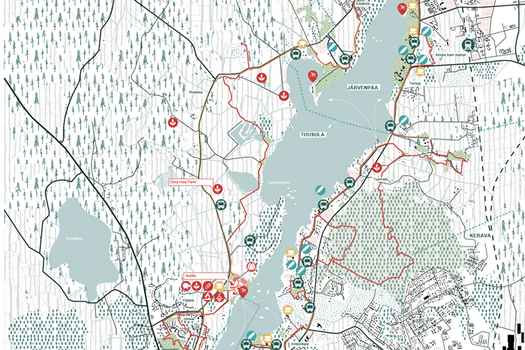
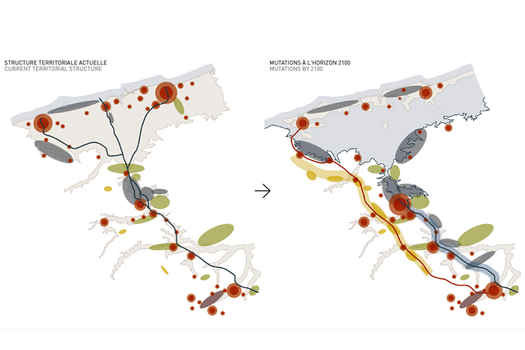
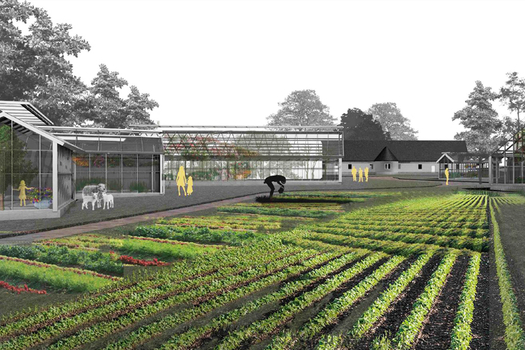
2. INCLUSIVE SETTINGS
No innovation without connection: the motto of the winning project Rambla + Kapsalon (fig.7) in Rotterdam Visserijplein (NL), also emphasises the placement and spacing of a pattern of socialisation as the primary condition for (re)making a milieu. The Europan project site is a square located in the heart of BoTu, a multicultural neighbourhood identified by the city as “vulnerable”. While the goal is to give the area a socio-economic boost, the focus of the winning team’s proposal is nevertheless to create a sense of community, seen as an essential preliminary stage in the neighbourhood’s economic and productive redevelopment. The project is structured around the figure of the rambla: a broad avenue with plantings that reshapes the space of the existing square along a new axis, extending the revitalisation from the centre of the neighbourhood towards its outer edges. Identifiable by its handling of the ground surface, as well as by the multicoloured patterns of its canopy, designed to shelter the market from rain, the rambla is not projected into the area like some fully predetermined and frozen structure. On the contrary, it aims to be the urban expression of a system of resilient public spaces, inclusive and diverse, capable of adapting to future practices and needs, open to multiple possible arrangements and coexistences between new and existing dynamics.
3. ATTACHMENT SETTINGS
From the redevelopment of the old dockland area of Helsingborg (SE), the special mention project The Beach (fig.8) introduces a multi-programmatic strip made up of a variety of public situations, which connects the urban fabric and its existing green spaces to the sea. Among these different situations, we find new gardens and green spaces, a food market and broad terraces, extensions to the canal and new public swimming pools, but also dedicated beach-sport and sunbathing areas. In fact, it is the beach, with its modes of occupancy and tacit principles of organisation, that the project team has chosen as its new principle of arrangement. However, the beach is also the sacred sphere of leisure and recreation, and it is precisely this atmosphere – imbued with pleasure and pastimes – that it seeks to establish in order to revitalise the abandoned docklands. For The Beach, a productive urban milieu must above all produce pleasure and leisure, new forms of attachment between a territory and its occupants, and reinforce the joyful sense of belonging to a dynamic urban milieu.
Through these spatial and unifying reconfigurations (the courtyard, the avenue, the beach), the teams implant the seeds of new shared values by imagining new spatiotemporal rituals that help to reinforce territorial social cohesion.
III- CONSTRUCTING THE TIMEFRAMES OF TRANSFORMATION
Europan increasingly asks teams to think about the notion of transformation processes as drivers of gradual and economically sustainable territorial change. From this perspective, time, as a social and human construct, itself becomes a productive element. Constructing time is a way to project the rhythms (H.Lefebvre, 1992) of the spaces/times and the successive states that will lead to a gradual regeneration of milieux. Following the current of what is called today temporal urbanism (L.Gwiazdzinski, 2013), the advantages of this processual approach seem multiple.
1. TESTING, PROTOTYPING
An immediate way of using small, reversible and low cost interventions to pre-test outcomes. Architectural, urban and landscape intentions can be translated in different ways in order to implement forms of intervention that are halfway between reversible and permanent. A first significant intervention can act as a seed of transformation. It is precisely on this potentially seminal role in the transformation of Magasin 405 in Helsingborg (SE) that the winning team in A Seat at the Table relies (fig.9). The team thus proposes to convert the place gradually, in a process punctuated by different periods of temporary occupancy. In order to match the calendar of H22 City expo, the team proposes creating a monumental circular opening, pierced upward through the different levels of the warehouse, in such a way that the building can be rediscovered and enjoyed in a new light. The open well is conceived as an atrium, in the centre of which performances and other artistic events can be held. In this first stage of occupancy, therefore, art is employed as a way to re-appropriate existing urban objects and places. These temporary artistic interventions act as new and revitalising spatial experiments with multiple potentials – for future exploration – and help to catalyse a collective desire to see these spaces lastingly transformed.
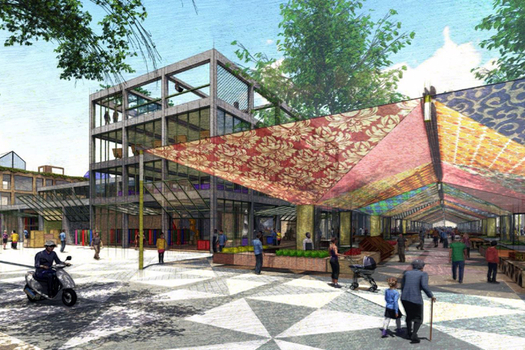
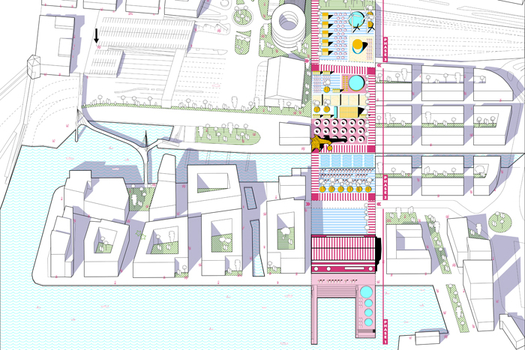
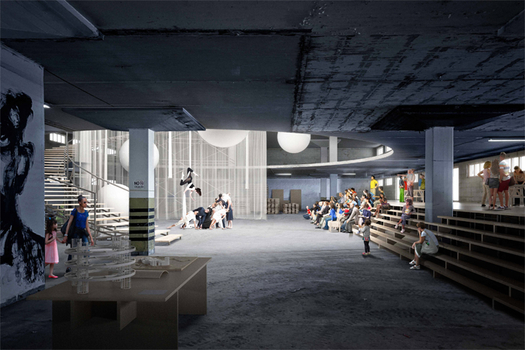
2. REAPPROPRIATING, OR RE-AESTHETICISING
Constructing the change process and generating inclusive new rhythms of interaction with the milieu. Silent transformations can be brutal and opaque. Allowing time for change is a way to implant new forms of dialogue between the milieu in transition and the (future) users, by encouraging a process of individual and collective support for the adoption of change. This is precisely what is happening in Saint-Omer (FR), where the runner-up team behind 9 Places to the Sea (fig.10, 11) proposes to implement an event-based process to prepare the transformation of the area. Exploring the sites and identifying the strategic places for intervention, organising landscape and city walks, setting up an itinerant biennial to establish new patterns of cultural encounter: with these instruments of territorial discovery and reappropriation, the aim is to emphasise the construction of a shared vision of possible transformation as a necessary preliminary. This desire to rethink the instruments of project design and representation also expresses a wish to re-aestheticise the objectives of the project, provided that “the word aesthetic is understood in its former sense of the capacity to “perceive” and to be “concerned”, in other words a capacity to sensitise oneself” (B.Latour, 2014).
3. ADAPTING, MAKING ADAPTABLE
Cultivating fertile uncertainty and the possibilities of readjustment during transformation requires the adoption of a more flexible and adaptable way of city making. In Bergische Kooperation (DE), the winning team behind Bergisch Plugin (fig.12) employs different instruments to adapt the project over time: the toolbox, phases and scenarios. Whether used individually and/or in combination, they are a way to implant acupunctural solutions and to adjust the next stage of transformation to take account of the initial effects. The toolbox functions as a set of generic solutions that can be applied locally in different places, giving global coherence to the whole territory covered by the intermunicipal partnership in Bergische. This consists of a discontinuous mesh that can be either pursued and reinforced or readjusted to take account of the impact of the first regeneration projects. The rules are therefore clear, but their application and development remain flexible. The phases proposed for the project are more guidelines than prescriptions: they help to trigger a long-term effort, to provide a vehicle for transformation that might bifurcate at certain points during the development of the project. Scenarios express the reversible and adaptable aspect of the initial locations that drive the process-project. The timeframes shape and activate the many spatial potentials, giving even greater scale to the new reality thus constructed.
What distinguishes these different process-project strategies is the quest for handholds in and with the real that will be used to implant the idea in the milieu and gradually to initiate its transformation. There are as many processes to be devised and undertaken as there are situations.
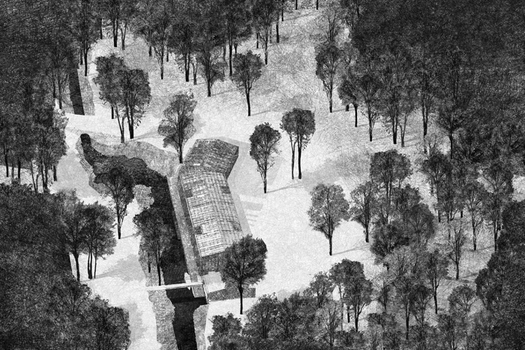
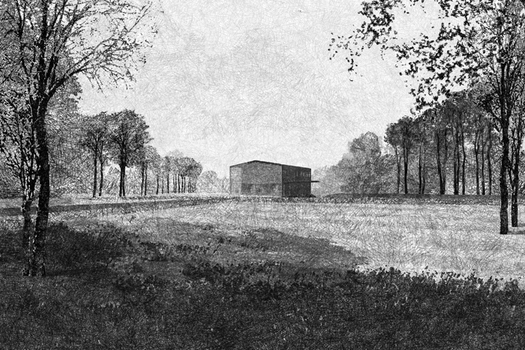
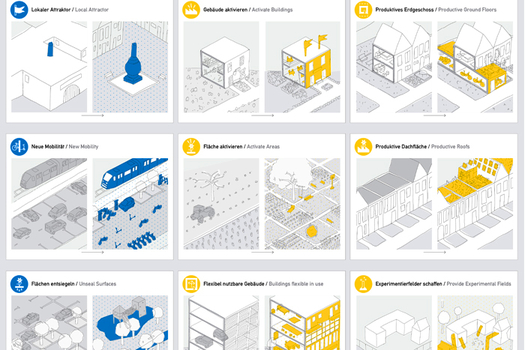
CONCLUSION
Whether the aim is to intensify the synergistic potential of nonhuman resources to become part of the milieu and to reconsider our metabolic attachments to the living world and to natural cycles; or to reorganise human settlements around new unifying and regenerative settings in order to activate new modes of cohabitation and coproduction; or to employ the timeframes of transformation as productive processual vehicles for the introduction of a more adaptable, inclusive and resilient form of city making, the spectrum of possible project strategies is becoming broader and richer. New productive milieus are implanted by interactions, interactions that are always multiple, varied and responsible, between everything that constitutes the living world. Ultimately, that is what the projects discussed here help us to see, to feel and to think.











